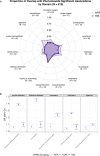This is a preprint.
Correlates of Risk for Disinhibited Behaviors in the Million Veteran Program Cohort
- PMID: 37034805
- PMCID: PMC10081391
- DOI: 10.1101/2023.03.22.23286865
Correlates of Risk for Disinhibited Behaviors in the Million Veteran Program Cohort
Update in
-
Correlates of Risk for Disinhibited Behaviors in the Million Veteran Program Cohort.JAMA Psychiatry. 2024 Feb 1;81(2):188-197. doi: 10.1001/jamapsychiatry.2023.4141. JAMA Psychiatry. 2024. PMID: 37938835 Free PMC article.
Abstract
Background: Many psychiatric outcomes are thought to share a common etiological pathway reflecting behavioral disinhibition, generally referred to as externalizing disorders (EXT). Recent genome-wide association studies (GWAS) have demonstrated the overlap between EXT and important aspects of veterans' health, such as suicide-related behaviors, substance use disorders, and other medical conditions.
Methods: We conducted a series of phenome-wide association studies (PheWAS) of polygenic scores (PGS) for EXT, and comorbid psychiatric problems (depression, schizophrenia, and suicide attempt) in an ancestrally diverse cohort of U.S. veterans (N = 560,824), using diagnostic codes from electronic health records. We conducted ancestry-specific PheWASs of EXT PGS in the European, African, and Hispanic/Latin American ancestries. To determine if associations were driven by risk for other comorbid problems, we performed a conditional PheWAS, covarying for comorbid psychiatric problems (European ancestries only). Lastly, to adjust for unmeasured confounders we performed a within-family analysis of significant associations from the main PheWAS in full-siblings (N = 12,127, European ancestries only).
Results: The EXT PGS was associated with 619 outcomes across all bodily systems, of which, 188 were independent of risk for comorbid problems of PGS. Effect sizes ranged from OR = 1.02 (95% CI = 1.01, 1.03) for overweight/obesity to OR = 1.44 (95% CI = 1.42, 1.47) for viral hepatitis C. Of the significant outcomes 73 (11.9%) and 26 (4.5%) were significant in the African and Hispanic/Latin American results, respectively. Within-family analyses uncovered robust associations between EXT and consequences of substance use disorders, including liver disease, chronic airway obstruction, and viral hepatitis C.
Conclusion: Our results demonstrate a shared polygenic basis of EXT across populations of diverse ancestries and independent of risk for other psychiatric problems. The strongest associations with EXT were for diagnoses related to substance use disorders and their sequelae. Overall, we highlight the potential negative consequences of EXT for health and functioning in the US veteran population.
Figures




References
-
- Degenhardt L, Charlson F, Ferrari A, et al. The global burden of disease attributable to alcohol and drug use in 195 countries and territories, 1990–2016: a systematic analysis for the Global Burden of Disease Study 2016. Lancet Psychiatry. 2018;5(12):987–1012. doi:10.1016/S2215-0366(18)30337-7 - DOI - PMC - PubMed
Publication types
Grants and funding
LinkOut - more resources
Full Text Sources
